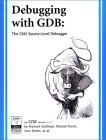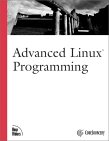GNU GDB Debugger Command Cheat Sheet
来源:互联网 发布:sqlserver insert 时间 编辑:程序博客网 时间:2024/04/28 08:58
GNU GDB Debugger Command Cheat Sheet
http://super-jiju.spaces.live.com/blog/cns!806C498DDEE76B61!565.entry
GDB Command Line Arguments:
Starting GDB:
- gdb name-of-executable
- gdb -e name-of-executable -c name-of-core-file
- gdb name-of-executable -pid process-id
(Use ps -auxw to list process id's.)
Command line options: (version 6. Older versions use a single "-")
-
Option Description --help
-h List command line arguments --exec=file-name
-e file-name Identify executable associated with core file. --core=name-of-core-file
-c name-of-core-file Specify core file. --command=command-file
-x command-file File listing GDB commands to perform. Good for automating set-up. --directory=directory
-d directory Add directory to the path to search for source files. --cd=directory Run GDB using specified directory as the current working directory. --nx
-n Do not execute commands from ~/.gdbinit initialization file. Default is to look at this file and execute the list of commands. --batch -x command-file Run in batch (not interactive) mode. Execute commands from file. Requires -x option. --symbols=file-name
-s file-name Read symbol table from file file. --write Enable writing into executable and core files. --quiet
-q Do not print the introductory and copyright messages. --tty=device Specify device for running program's standard input and output. --pid=process-id
-p process-id
-c process-id Specify process ID number to attach to.
GDB Commands:
Commands used within GDB:
-
Command Description help List gdb command topics. help topic-classes List gdb command within class. help command Command description. apropos search-word Search for commands and command topics containing search-word. info args
i args List program command line arguments info breakpoints List breakpoints info break List breakpoint numbers. info break breakpoint-number List info about specific breakpoint. info watchpoints List breakpoints info registers List registers in use info threads List threads in use info set List set-able optionBreak and Watch
break line-number Suspend program at specified function of line number. break +offset
break -offset Set a breakpoint specified number of lines forward or back from the position at which execution stopped. break filename:function Don't specify path, just the file name and function name. break filename:line-number Don't specify path, just the file name and line number. break *address Suspend processing at an instruction address. Used when you do not have source. break line-number if condition Where condition is an expression. i.e. x > 5
Suspend when boolean expression is true. break line thread thread-number Break in thread at specified line number. Use info threads to display thread numbers. tbreak Temporary break. Break once only. Break is then removed. See "break" above for options. watch condition Suspend processing when condition is met. i.e. x > 5 clear
clear function
clear line-number Delete breakpoints as identified by command option. delete
d Delete all breakpoints, watchpoints, or catchpoints. delete breakpoint-number
delete range Delete the breakpoints, watchpoints, or catchpoints of the breakpoint ranges specified as arguments. disable breakpoint-number-or-range
enable breakpoint-number-or-range Does not delete breakpoints. Just enables/disables them.
Example:
Show breakpoints: info break
Disable: disable 2-9 enable breakpoint-number once Enables once continue
c Continue executing until next break point/watchpoint. continue number Continue but ignore current breakpoint number times. Usefull for breakpoints within a loop. finish Continue to end of function.Line Execution
s
step number-of-steps-to-perform Step to next line of code. Will step into a function. next
n
next number Execute next line of code. Will not enter functions. until
until line-number Continue processing until you reachaaspecified line number. Also: function name, address, filename:functionor filename:line-number. stepi
si
nexti
ni step/next assembly/processor instruction. info signals
info handle
handle SIGNAL-NAME option Perform the following option when signal recieved: nostop, stop, print, noprint, pass/noignore or nopass/ignore where Shows current line number and which function you are in.Stack
bt
bt inner-function-nesting-depth
bt -outer-function-nesting-depth Show trace of where you are currently. Which functions you are in. Prints stack backtrace. backtrace full Print values of local variables. frame number
f number Select frame number. up number
down number Move up/down the specified number of frames in the stack. info frame List address, language, address of arguments/local variables and which registers were saved in frame. info args
info locals
info catch Info arguments of selected frame, local variables and exception handlers.Source Code
l
list line-number
list function
list -
list start#,end#
list filename:function List source code. set listsize count
show listsize Number of lines listed when list command given. directory directory-name
dir directory-name
show directories Add specified directory to front of source code path. directory Clear sourcepath when nothing specified.Examine Variables
p variable-name
p file-name::variable-name
p 'file-name'::variable-name Print value stored in variable. p *array-variable@length Print first # values of array specified by length. Good for pointers to dynamicaly allocated memory. p/x variable Print as integer variable in hex. p/d variable Print variable as a signed integer. p/u variable Print variable as a un-signed integer. p/o variable Print variable as a octal. p/t variable
x/b address
x/b &variable Print as integer value in binary. (1 byte/8bits) p/c variable Print integer as character. p/f variable Print variable as floating point number. p/a variable Print as a hex address. x/w address
x/4b &variable Print binary representation of 4 bytes (1 32 bit word) of memory pointed to by address.GDB Modes
set logging off
show logging
set logging file log-file Turn on/off logging. Default name of file is gdb.txt set print array on
set print array off
show print array Default is off. Convient readable format for arrays turned on/off. set print array-indexes on
set print array-indexes off
show print array-indexes Default off. Print index of array elements. set print pretty on
set print pretty off
show print pretty Format printing of C structures. set print union on
set print union off
show print union Default is on. Print C unions. set print demangle on
set print demangle off
show print demangle Default on. Controls printing of C++ names.Start and Stop
r
run command-line-arguments
run < infile > outfileStart program execution from the beginning of the program. The command break main will get you started. Also allows basic I/O redirection.continue
cContinue execution to next break point.killStop program execution. quit
q Exit GDB debugger.
GDB Operation:
- Compilewith the "-g" option (for most GNU and Intel compilers) which generatesadded information in the object code so the debugger can match a lineof source code with the step of execution.
- Do not usecompiler optimization directive such as "-O" or "-O2" which rearrangecomputing operations to gain speed as this reordering will not matchthe order of execution in the source code and it may be impossible tofollow.
- control+c: Stop execution. It can stop program anywhere, in your source or a C library or anywhere.
- To execute a shell command: ! command
or shell command - GDB command completion: Use TAB key
info bre + TAB will complete the command resulting in info breakpoints
Press TAB twice to see all available options if more than one option is available or type "M-?" + RETURN. - GDB command abreviation:
info bre + RETURN will work as bre is a valid abreviation for breakpoints
De-Referencing STL Containers:
Displaying STL container classes using the GDB "p variable-name"results in an cryptic display of template definitions and pointers.Use the following ~/.gdbinit file (V1.03 09/15/08). Now works with GDB 4.3+.
(Archived versions: [V1.01 GDB 6.4+ only])
Thanks to Dr. Eng. Dan C. Marinescu for permission to post this script.
Use the following commands provided by the script:
Data type GDB command std::vector<T>pvector stl_variablestd::list<T>plist stl_variable Tstd::map<T,T>pmap stl_variablestd::multimap<T,T>pmap stl_variablestd::set<T>pset stl_variable Tstd::multiset<T>pset stl_variablestd::deque<T>pdequeue stl_variablestd::stack<T>pstack stl_variablestd::queue<T>pqueue stl_variablestd::priority_queue<T>ppqueue stl_variablestd::bitset<n>td>pbitset stl_variablestd::stringpstring stl_variablestd::widestringpwstring stl_variableWhere T refers to native C++ data types. While classes and other STLdata types will work with the STL container classes, this de-referencetool may not handle non-native types.
Also see the YoLinux.com STL string class tutorial and debugging with GDB.
De-Referencing a vector:
Example: STL_vector_int.cpp
#include <iostream>
Compile: g++ -g STL_vector_int.cpp
#include <vector>
#include <string>
using namespace std;
main()
{
vector<int> II;
II.push_back(10);
II.push_back(20);
II.push_back(30);
cout << II.size() << endl;
}
Debug in GDB: gdb a.out
(gdb) l
Notice the native GDB print "p" results in an cryptic display while the "pvector"routine from the GDB script provided a human decipherable display of your data.
1 #include
2 #include
3 #include
4
5 using namespace std;
6
7 main()
8 {
9 vector II;
10
(gdb) l
11 II.push_back(10);
12 II.push_back(20);
13 II.push_back(30);
14
15 cout << II.size() << endl;
16
17 }
(gdb) break 15
Breakpoint 1 at 0x8048848: file STL_vector_int.cpp, line 15.
(gdb) r
Starting program: /home/userx/a.out
Breakpoint 1, main () at STL_vector_int.cpp:15
15 cout << II.size() << endl;
(gdb) p II
$1 = {
>> = {
_M_impl = {
> = {
<__gnu_cxx::new_allocator> = {}, },
members of std::_Vector_base >::_Vector_impl:
_M_start = 0x804b028,
_M_finish = 0x804b034,
_M_end_of_storage = 0x804b038
}
}, }
(gdb) pvector II
elem[0]: $2 = 10
elem[1]: $3 = 20
elem[2]: $4 = 30
Vector size = 3
Vector capacity = 4
Element type = int *
(gdb) c
Continuing.
3
Program exited normally.
(gdb) quit
De-Referencing a 2-D vector of vectors:
Example: STL_vector_int_2.cpp
#include <iostream>
Compile: g++ -g STL_vector_int_2.cpp
#include <vector>
using namespace std;
main()
{
vector< vector > vI2Matrix(3, vector(2,0));
vI2Matrix[0][0] = 0;
vI2Matrix[0][1] = 1;
vI2Matrix[1][0] = 10;
vI2Matrix[1][1] = 11;
vI2Matrix[2][0] = 20;
vI2Matrix[2][1] = 21;
cout << "Loop by index:" << endl;
int ii, jj;
for(ii=0; ii < 3; ii++)
{
for(jj=0; jj < 2; jj++)
{
cout << vI2Matrix[ii][jj] << endl;
}
}
}
Debug in GDB: gdb a.out
(gdb) l
Note "pvector" does not de-reference the entire vector ofvectors all at once but returns vectors $1, $2 and $3. The "pvector"command then helps us traverse the information by examining thecontents of each element in the individual "terminal" vectors.Note that the native gdb "p vI2Matrix" (last command) was much lessinformative.
1 #include
2 #include
3
4 using namespace std;
5
6 main()
7 {
8 vector< vector > vI2Matrix(3, vector(2,0));
9
10 vI2Matrix[0][0] = 0;
(gdb) l
11 vI2Matrix[0][1] = 1;
12 vI2Matrix[1][0] = 10;
13 vI2Matrix[1][1] = 11;
14 vI2Matrix[2][0] = 20;
15 vI2Matrix[2][1] = 21;
16
17 cout << "Loop by index:" << endl;
18
19 int ii, jj;
20 for(ii=0; ii < 3; ii++)
(gdb) break 17
Breakpoint 1 at 0x8048a19: file STL_vector_2.cpp, line 17.
(gdb) r
Starting program: /home/userx/a.out
Breakpoint 1, main () at STL_vector_2.cpp:17
17 cout << "Loop by index:" << endl;
(gdb) pvector vI2Matrix
elem[0]: $1 = {
>> = {
_M_impl = {
> = {
<__gnu_cxx::new_allocator> = {}, },
members of std::_Vector_base >::_Vector_impl:
_M_start = 0x804b040,
_M_finish = 0x804b048,
_M_end_of_storage = 0x804b048
}
}, }
elem[1]: $2 = {
>> = {
_M_impl = {
> = {
<__gnu_cxx::new_allocator> = {}, },
members of std::_Vector_base >::_Vector_impl:
_M_start = 0x804b050,
_M_finish = 0x804b058,
_M_end_of_storage = 0x804b058
}
}, }
elem[2]: $3 = {
>> = {
_M_impl = {
> = {
<__gnu_cxx::new_allocator> = {}, },
members of std::_Vector_base >::_Vector_impl:
_M_start = 0x804b060,
_M_finish = 0x804b068,
_M_end_of_storage = 0x804b068
---Type to continue, or q to quit---
}
}, }
Vector size = 3
Vector capacity = 3
Element type = class std::vector > *
(gdb) pvector $1
elem[0]: $4 = 0
elem[1]: $5 = 1
Vector size = 2
Vector capacity = 2
Element type = int *
(gdb) pvector $2
elem[0]: $6 = 10
elem[1]: $7 = 11
Vector size = 2
Vector capacity = 2
Element type = int *
(gdb) pvector $3
elem[0]: $8 = 20
elem[1]: $9 = 21
Vector size = 2
Vector capacity = 2
Element type = int *
(gdb) p vI2Matrix
$10 = {
>,std::allocator > > >> = {
_M_impl = {
> >> = {
<__gnu_cxx::new_allocator > >> = {}, },
members of std::_Vector_base >,std::allocator > > >::_Vector_impl:
_M_start = 0x804b018,
_M_finish = 0x804b03c,
_M_end_of_storage = 0x804b03c
}
}, }
(gdb) quit
Man Pages:
- gdb - GNU debugger
- ld - Linker
- gcc/g++ - GNU project C and C++ compiler
Links:
- Gnu.org: GDB manual
- Postscript file: GDB: Quick reference
 Books:
Books:
 "Debugging with GDB: The GNU Source-Level Debugger"
"Debugging with GDB: The GNU Source-Level Debugger" by Richard Stallman, Roland H. Pesch, Stan Shebs
ISBN # 1882114884, Free Software Foundation; 9th edition (January 1, 2002)
 "GDB Pocket Reference"
"GDB Pocket Reference" by Arnold Robbins
ISBN # 0596100272, O'Reilly
 "Advanced Linux Programming"
"Advanced Linux Programming" by Mark Mitchell, Jeffrey Oldham, Alex Samuel, Jeffery Oldham
ISBN # 0735710430, New Riders
Good book for programmers who already know how to program and just need to know the Linux specifics. Covers a variety of Linux tools, libraries, API's and techniques. If you don't know how to program, start with a book on C.
 Dr. Dobb's Journal
Dr. Dobb's Journal Free subscription to the premier resource forprofessional programmers and software developers. Multi-language andmulti-platform
- GNU GDB Debugger Command Cheat Sheet
- GNU GDB Debugger Command Cheat Sheet
- GNU GDB Debugger Command Cheat Sheet
- VxWorks Command Cheat Sheet
- Vim Command Cheat Sheet
- GDB GNU Debugger Intro
- GNU GDB Debugger
- Chapter 3. GNU Debugger (gdb)
- GDB: The GNU Project Debugger
- 学习使用 GNU GDB Debugger
- OpenStack command-line interface cheat sheet
- 一个较全的gdb调试文档:gdb cheat sheet
- GNU Project Debugger: More fun with GDB
- Cheat Sheet
- Cheat Sheet
- Debugging With Gdb - The Gnu Source-Level Debugger
- Debugging with GDB: The GNU Source-Level Debugger
- GNU Project Debugger:使用 GDB 的更多乐趣
- whaosoft 心情!
- Linux下gcc编译中关于头文件与库文件搜索路径相关问题
- AOL Seach query database
- atoi,atof,fread(fwrite)
- linux 下配置samba服务器参数详解
- GNU GDB Debugger Command Cheat Sheet
- 如何使用搜索引擎 zZ
- 堆和栈(转)
- 手机无线连接(GSM/GPRS)方式
- 特征值与特征向量的数值计算; Matrix Eigenvalues and Eigenvectors Calculating
- 说说拼写检查,spell checking
- 选股法宝—量比与换手率的综合运用(上下集.原创)(转载)
- 基本FIS编辑器
- 那些纷纷倒下的 Web 2.0 公司


